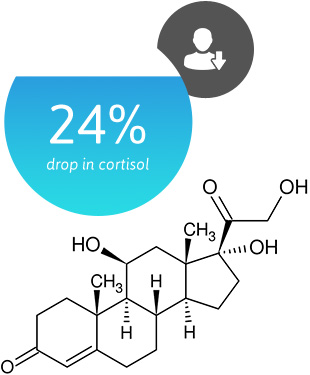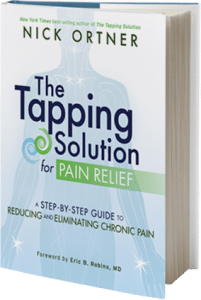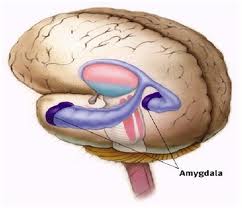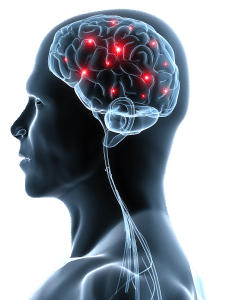If you have a fear or phobia, you know how uncomfortable or even how debilitating it can be. If you want to learn how to use Tapping to overcome ANY fears or phobias, big or small, I’ve pulled out Chapter 11 from my first book, “The Tapping Solution,” to help you.
Lindsey was terrified of clowns.
I know, it sounds pretty funny. I can hear you snickering: “Clowns? Really? This is a serious problem? She was scared of clowns?”
But the reality is, clowns terrified her. While it might seem amusing to those of us who don’t share that fear—and while she was aware that it wasn’t rational—she was frightened nonetheless.
Lindsey is a fun, bright, happy 24-year-old and one of the team members at our company, The Tapping Solution. When she was five years old, she had walked in the room while her parents watching the Stephen King miniseries It, which features a murderous clown.
While she has no recollection of the incident—her parents told her what happened and why they feel this is where her fear of clowns started. Clearly something made an impression on her.
I had known about her fear but didn’t understand how serious it was. Then I heard from another team member that Lindsey had seen a picture of a clown and had started crying. I realized at that moment that this was a full-blown phobia that was affecting her life.
This fear perfectly illustrates an underlying element of all fears and phobias: the conditioned response. It’s not a logical fear, and it serves no purpose. But once the pattern
has been programmed into the system, the conscious mind cannot override it.
While the clown phobia seems especially amusing, the pattern is the same whether the fear is about public speaking, enclosed spaces, heights, needles, germs and dis-ease, dentists, or snakes. The phobia usually starts with a negative experience. After that, the patterns of fear keep running again and again, each time the person encounters that scenario.
You might argue that the fear of snakes is real—snakes can be dangerous—whereas the fear of clowns is not real because clowns aren’t dangerous. Yes, humans have a natural, smart, genetic tendency to be wary of potentially dangerous snakes; that’s very different from a phobia.
I don’t have a snake phobia, but I would be scared if a venomous cobra were in my office right now. That’s a natural and rational response. What makes a phobia different is that it is not rational. The fear is present even if there is a nondangerous snake in an enclosed cage across the room.
Likewise, most of us would be a little nervous about speaking in front of 5,000 people; even speakers who have done it hundreds of times might feel a little agitation or excitement. A phobia, on the other hand, would keep us from putting ourselves in that situation in the first place!
You might remember that the original tapping breakthrough happened when Roger Callahan was working with Mary on her water phobia. Her fear disappeared instantly after tapping. It worked then and continues to work very effectively with fears and phobias of all varieties.
Using EFT to Clear Out Fears and Phobias
In just about an hour of tapping, we turned around Lindsey’s phobia. I’m sharing the process with you here, because it’s similar, no matter what fear you’re working with.
Even talking about clowns made Lindsey anxious and fearful. So we began the tapping with the very simple and broad statement Even though I have this fear of clowns, I choose to relax now. Go slowly with fears and phobias; there’s no reason to suffer through the process.
We did several rounds of Even though I have this fear of clowns . . . and then tapped through the points, repeating “this fear of clowns . . . this anxiety . . . this stress in my body . . . ” We continued until she found herself calm and relaxed. Now I was able to ask her when the fear had started.
She shared with me what she had heard from her parents—the experience of seeing the movie It as a child and being terrified. She didn’t have a conscious memory of this experience and
didn’t feel anxiety when she talked about what her parents had told her. But just to be sure, we did some tapping on it. We proceeded to tap on Even though I saw this scary movie when I was a kid, I deeply and completely accept myself.
Again, we weren’t able to measure a level on it, because she wasn’t emotional about it, but I felt it would be smart to do a couple of rounds just in case. At this point, I could see that Lindsey was relaxed, so I took the next step. Confronting fears and phobias is all about baby steps. (You may remember the concept of “baby steps” from the movie What About Bob? with Bill Murray—what
we’re doing is not that different!)
So I went on to ask Lindsey, “If I were to show you a picture of a clown right now, how would you feel?” Notice I didn’t say, “I’m going to show you a picture of a clown” or “Think of a scary clown.” I wanted to continue to ease her into the process. “I’d be a little scared,” she replied. “I’m feeling a little anxious right now.” So we went on to tap on that—Even though I’m feeling a little scared . . . and so forth—until she found herself calm again.
“Lindsey, I’m going to send you a picture of a clown via e-mail,” I went on. “How does that feel? Are you okay with that?” “Yes,” she said. “That’s fine.” We were doing this session over Skype video, so right away I sent her a drawing of a cartoon clown. She opened it up, and I asked her, “How do you feel when you see that?” "A little anxious,” she replied. So we tapped on that until her anxiety
went down.
From there, we went on to look at a photograph of a real clown. This is where it gets interesting. When she saw the picture of the real clown, she said, “I hate the red nose. That really freaks me out.” This was an aspect of her phobia. With phobias, you want to be especially careful to look for all the different aspects of the issue—and to clear them all in order to have full relief.
An aspect will always be specific. If Lindsey is specifically scared by the red nose, just tapping on Even though I have this fear of clowns . . . might not clear the fear. So we had to be more
specific, tapping on Even though this red nose really freaks me out. . . .
We continued to tap on more and more pictures of clowns. Finally, I sent her a picture of the clown from the movie It. I warned her beforehand, and we tapped on her anxiety about even seeing it. Then, when the anxiety number was down, she looked at it, and we tapped. After several rounds, she was able to look at the clown image and say, “I don’t like the clown. He’s creepy, but I can look at him and my body feels fine.” When I looked at the creepy It clown, I felt the same way!
She no longer had a phobia of clowns. She didn’t like looking at creepy clowns—but neither do most of the rest of us! Our work was a success.
Identifying with Fears and Phobias
One interesting thing to note about the session with Lindsey is that something that came up toward the end, as the phobia was clearing. She got visibly upset and said, “I don’t know who I will be without this fear.” Again, I know it seems amusing because her fear was about clowns, but it is so indicative of the patterns we all run—no matter the challenge, fear, or phobia.
Being afraid of clowns was part of who Lindsey was. At some level, she defined herself that way: “I am afraid of clowns.” She had grown up afraid of clowns, all her friends knew she was afraid of clowns, and she took actions to make sure she didn’t face clowns in her life. This fear was part of the fabric of her life, her identity. Who would she be without it?
We tapped on Even though I don’t know who I’ll be without this fear of clowns . . . and Even though I’m used to being afraid of clowns, I don’t know how to act without this fear, I deeply and completely accept myself. And so forth. These statements began opening up her mind and body to a new possibility, and she then started shaping a new identity without this limiting fear.
She can continue to tap on positive statements of her new identity, such as I am someone who is free of phobias; I now find clowns funny; I choose to be courageous, fun, and bold, even around clowns! and so forth. This serves to reinforce the new identity that she’s already partially stepped into, and it is likely to give her even greater confidence. Without reinforcing the change by tapping
in more positive statements, she might not be scared of clowns, but not have any positive emotions around them, either.
Tapping further can make any encounter she has with them fun!
It’s Not about Being Brave or Not
Kris Carr is a brave woman. She’s spent the past 10 years battling a rare cancer, documenting her journey in the film Crazy Sexy Cancer and being a guiding light to millions through her
film and New York Times best-selling books. In other words, she is no stranger to overcoming obstacles and living a life of freedom, high energy, and joy.
So as we walked together up a mountain near her home in Woodstock, New York, I was surprised by something she shared with me. She was saying that at the top of the mountain there’s a steel tower you can climb and see in all directions for miles. I said, “Great, let’s go up!” to which she replied, “Oh, no, I’m not going up there! I’m scared of heights.”
She instantly knew she’d said that to the wrong guy. If an issue is tappable, I’m going to get you tapping! And what’s more obviously tappable than a fear of heights?
I promised her the experience would be painless; she wouldn’t have to do anything she didn’t want to do. So we began tapping right then and there, starting with the anxiety she was feeling at the thought of tapping.
Just like talking about clowns made Lindsey anxious, the possibility of having to face any heights made Kris anxious. Her body and mind started imagining negative future scenarios and creating fear around them, even though they weren’t real and hadn’t happened yet.
Kris and I spent the rest of the climb up the mountain tapping on the anxiety she was feeling. By the time we got to the top, she felt calm. I took a look at the tower. It was perfect, because it had multiple sets of steps at various levels. She could take her time, moving up the levels slowly, tapping each step of the way.
We started at the bottom of the platform, tapping on the anxiety she was feeling. We went back and forth between the global statement Even though I have this fear of heights . . . and specific statements about her body state, both emotional and physical.
For example we tapped on
Even though I feel all this anxiety . . .
Even though I feel like I can’t take a deep breath . . .
Even though I have this knot in my stomach . . .
Even though my body feels shaky . . .
Even though I’m scared of falling . . .
We systematically worked through the different aspects that were coming up in her mind and body. Slowly, we started climbing. We went step by step, only moving when she felt comfortable and safe. Up we went, tapping and climbing together the whole way.
Her loving husband, Brian, was there with us, shaking the platform as we climbed to make sure she really overcame her phobia. (Not a recommended strategy when someone wants to get over a
phobia, by the way, and Kris certainly let Brian know how she felt about his contribution!)
When we got to the top, Kris’s reward for having overcome her lifelong fear of heights was a majestic autumn view for miles in every direction. An appropriate metaphor for the reward we get when we finally let go of those lifelong fears, phobias, and limiting beliefs: we can then see a beautiful, clear view of our lives and the world.
Two Fears Handled in One Hour
Meggan is a dynamic writer, lecturer, and coach to thousands of women around the world. She was scheduled to speak at an important conference and reached out to me for some help. Meggan had often taken the stage before, with extremely positive feedback from her audiences. But up until that point, she always read her speeches from behind a podium. She never felt fully comfortable with the experience, either.
For the upcoming event, she wouldn’t have a podium. She was also planning on speaking without a set script. The prospect terrified her, so she reached out to me, having heard how effective EFT could be when it came to public speaking phobias.
When we began our session, I asked her to visualize being onstage, without the podium or her written speech, and to tell me what she experienced. Particularly, I wanted to know what she felt in her body. I find that focusing on physical sensations is a great way to get started addressing fears, because it helps us connect more fully to the feelings and determine what’s really going on.
She shared with me that she felt a constriction in her chest and throat when she thought about the event; not a surprising location for a fear of public speaking. I asked her to give the constriction a number, and she said it was a 7 on a 0-to-10 scale.
We began tapping with some very simple statements:
Even though I have this constriction in my chest and throat, I deeply and completely accept myself.
Even though something feels stuck in my throat, I deeply and completely accept myself.
Even though I have this anxiety in my chest and throat, I choose to relax now.
We kept tapping through various statements and the points, until she could no longer feel the constriction in her chest and throat. I then had her go back to the image of herself speaking up onstage at the event. What did she feel? What did she see? She shared that she felt better and saw the speech going well, but only once she got started.
“I think getting started is going to be tough,” she said. We’d cleared out the stuck energy in her chest and throat, and now the next aspect of her phobia had arisen. So we tapped on the issue of getting started until it cleared and she felt confident enough to continue.
I continued to ask her to visualize the event and to look for anything that didn’t feel right. I even added to the potential pressure, on purpose, in order to make sure everything was clear. For example, I had her visualize the audience not smiling when she first came out, to see if that would bring up any anxiety. Audiences are generally very receptive and welcoming to the speakers, but I wanted to push her buttons a little bit, to make sure we handled all the different aspects of her phobia.
This process continued, with more tapping, digging deeper and deeper, until she could no longer find any anxiety, stress, or worry about the speech. Instead, she reported, “I’m actually excited for this and starting to think about what I want to discuss. I could never go there before because I was too terrified of the whole experience!”
I’ve mentioned it several times but it bears repeating because it’s so crucial. The way to get lasting results with fears or phobias is to dig deep and address all the aspects of the issue. This is a time when it’s good to look for what’s wrong, to identify problems, to push within yourself and see how it feels!
Meggan was delighted with how she felt, and we were about to sign off from the call when she shared with me that she was excited to use EFT on her other fear: flying. She was going to have to fly to the event, after all!
The fear of public speaking had taken only 30 minutes to address, so I offered to continue helping her with the fear of flying right then, and she agreed.
She shared with me that 15 years earlier, she and her sister had flown together on a small airplane, and the flight was the worst experience of her life. From the start, the turbulence was unlike any she had ever experienced, with the small plane dropping several feet at once, again and again. She had been sure she was going to die. The pilot didn’t say a word to reassure the
passengers, and the muted cries and screams of the people around her made everything worse.
They finally landed safely, but to Meggan’s mind and body, the trauma of the experience never left. She had worked on healing and had made progress, but at the deepest level, the trauma was still there—affecting her life in all sorts of ways.
This wasn’t just a fear of flying that we were working on together, it was a deepseated fear about life—about safety, about who she was in the world, and about not having to be on alert at all times. That one experience had taught Meggan that she needed to be vigilant, that the world was inherently unsafe, and that her body wasn’t safe, either.
I used the “movie technique” with Meggan, asking her to recount to me what happened, while tapping at the same time. I could tell from Meggan’s body language and tone that just talking about the issue brought her some anxiety, so I was careful to move slowly. I told her that if she ever felt the emotional intensity was too high, or if she didn’t feel safe, we could back away from the experience.
This is one of the great things about working with people on video Skype or in person rather than by telephone: the visual cues give you invaluable information. Meggan recounted the story of the plane flight from start to finish. I focused on helping her feel safe, guiding her with questions that brought her deeper into the experience when needed and pulled her further out when things seemed to get too intense.
She told me what had happened, step by step, and tapped the whole time. Her first recounting of it was very emotional, but I could see her calming down as she tapped. I then had her tell me the story again, and again, and again, until there was no emotional intensity to any element of it. In the end, when she thought of the traumatic flight, she broke down in tears of joy because she was no longer experiencing the fear and pain that just 30 minutes earlier was paralyzing to her.
I’ll let an e-mail that I received from Meggan the next day give you a fuller idea of the results she experienced:
I’ve been sleeping like a teen since our call. If it weren’t for my toddler, I might still be in bed. It’s not fatigue; it feels more like make-up sleep. The part of me that was terrorized into hypervigilance during that flight 15 years ago, to stay awake, to keep watch, to be ever on the lookout for my safety finally took a bow and stepped down.
Not trusting life takes a lot of energy (smile). I have this visceral knowing that when the make-up sleep has run its course, I’m going to have crazy amazing energy. I’m so fascinated, and semiperplexed, at the session’s effectiveness. I keep trying to conjure the fear I once had for flying and also the naked, exposed feeling I had about speaking without a script in public, and I just can’t access it. It’s not there. I remember who I am, or who I was before these fears made a home for themselves within me. I don’t get how tapping works, and I don’t need to—it just does.
Tapping accessed the actual wound and just lifted it. Poof. Tapping returned to me the actual feeling of calm and safety in my body that the trauma of that flight has been blocking ever since. Like a magician pulling the white tablecloth out from under a dining set, tapping revealed that my trust in the world, in my life, has always been there—as my ground of being—and that the fear was simply obscuring its permanent presence within me.
I’m a convert. A smacked-on-the-forehead, true-believer convert. My gratitude is endless.
[fr-ch-optin]
Until next time,
Keep Tapping!
Nick Ortner
The article Eliminating Phobias and Fears was first published to: The Tapping Solution
 You’ve probably heard the Jerry Seinfeld joke:
You’ve probably heard the Jerry Seinfeld joke:


 They were then divided into three groups corresponding to the type of treatment received: tapping, supportive listening, and no treatment.
They were then divided into three groups corresponding to the type of treatment received: tapping, supportive listening, and no treatment. Their first step in
Their first step in  Interestingly, the researchers also looked at meta-analyses of psychiatric medication and therapy studies, and discovered that tapping reduced depression symptoms at a much higher rate than either of those accepted treatments.
Interestingly, the researchers also looked at meta-analyses of psychiatric medication and therapy studies, and discovered that tapping reduced depression symptoms at a much higher rate than either of those accepted treatments.
 The simple technique known as Tapping that I'll share with you on this page, along with the specific process I've outlined for you, will allow you to finally get to the root cause of your physical pain and release it... permanently!
The simple technique known as Tapping that I'll share with you on this page, along with the specific process I've outlined for you, will allow you to finally get to the root cause of your physical pain and release it... permanently! Most doctors have a huge gap in their understanding of physical pain, and the solutions for creating lasting pain relief.
Most doctors have a huge gap in their understanding of physical pain, and the solutions for creating lasting pain relief. Let's say, for example, that you went through a horrible divorce years ago. It needed to happen, and you now know you're better off as a result.
Let's say, for example, that you went through a horrible divorce years ago. It needed to happen, and you now know you're better off as a result. There's a growing body of research on the topic.
There's a growing body of research on the topic. If you're serious about wanting to eliminate physical pain from your body than this book is a must!
If you're serious about wanting to eliminate physical pain from your body than this book is a must! If you have been diagnosed with an autoimmune disease, and are struggling with the pain, the discomfort and the frustration, know that you are not alone!
If you have been diagnosed with an autoimmune disease, and are struggling with the pain, the discomfort and the frustration, know that you are not alone!
 Something stressful happens, or you start thinking about something stressful, like the the challenges you're having at work, at home with your kids, with your health or weight, or in your relationship...
Something stressful happens, or you start thinking about something stressful, like the the challenges you're having at work, at home with your kids, with your health or weight, or in your relationship... When you use Tapping to shift your unconscious beliefs and emotions, you shift the chemicals being released into the body. In doing so, you are literally able to shift your nervous system, as well as your digestive and endocrine systems, your hormones, your energy levels and more!
When you use Tapping to shift your unconscious beliefs and emotions, you shift the chemicals being released into the body. In doing so, you are literally able to shift your nervous system, as well as your digestive and endocrine systems, your hormones, your energy levels and more! This is a powerful meditation designed specifically to help your body get out of fight or flight. Through this soothing and balancing meditation you'll:
This is a powerful meditation designed specifically to help your body get out of fight or flight. Through this soothing and balancing meditation you'll: If you're serious about wanting to eliminate your autoimmune disorder than
If you're serious about wanting to eliminate your autoimmune disorder than  The element of Tapping that has been most frequently called into question is the acupressure points. This is quite possibly because there’s been only a few studies examining this one element as a critical component of Tapping’s effectiveness.
The element of Tapping that has been most frequently called into question is the acupressure points. This is quite possibly because there’s been only a few studies examining this one element as a critical component of Tapping’s effectiveness. Burnout is a serious and widespread issue in public education, and proposed programs to remedy the issue have been too expensive for most districts to implement.
Burnout is a serious and widespread issue in public education, and proposed programs to remedy the issue have been too expensive for most districts to implement. What were the results?
What were the results?